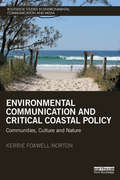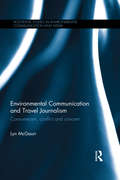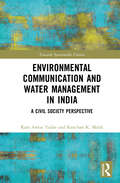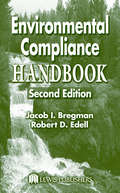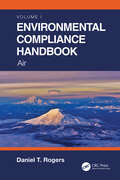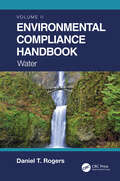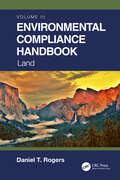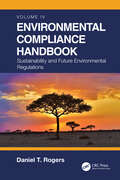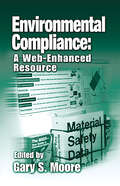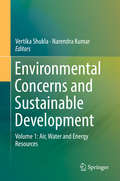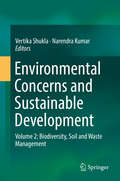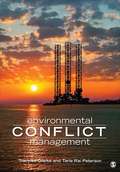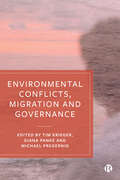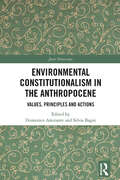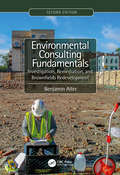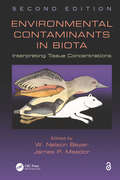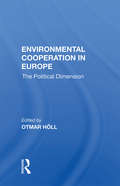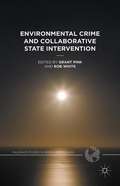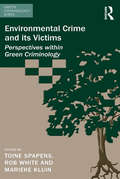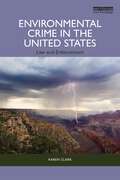- Table View
- List View
Environmental Communication and Critical Coastal Policy: Communities, Culture and Nature (Routledge Studies in Environmental Communication and Media)
by Kerrie Foxwell-NortonThe vast majority of the world’s population lives on or near the coast. These communities are an extraordinary and largely untapped resource that can be used to mitigate planetary disaster and foster environmental stewardship. Repeated waves of scientific fact and information are not inciting action, nor apparently producing enough momentum to change voting behaviour towards a progressive environmental politics. A critical coastal policy, underpinned by a deeper understanding of environmental communication, can offer something new to this status quo. Environmental Communication and Critical Coastal Policy argues that more science and ‘better’ communication has been largely responsible for the lacklustre response by citizens to environmental challenges. Foxwell-Norton asserts that the inclusion of a range of local meanings and cultural frameworks with which experts could engage would better incite participation in, and awareness of, local environmental issues. The value and possible role of ‘geo-community media’ (mainstream, alternative and social media) is examined here to illustrate and support the key argument that meaningful local engagement is a powerful tool in coastal management processes. This is a valuable resource for postgraduates, researchers and academics across environmental science and management, policy studies, communication studies and cultural studies.
Environmental Communication and Travel Journalism: Consumerism, Conflict and Concern (Routledge Studies in Environmental Communication and Media)
by Lyn McGaurrTravel journalism about natural attractions is environmental communication at the cusp of consumerism and concern. Countries and regions that market forests, rivers and wildlife to international tourists drive place-of-origin brand recognition that benefits exporters in other sectors. Place-branding in such destinations is not just PR for environmentally sustainable development and consumption, but also a political enterprise. Environmental Communication and Travel Journalism considers tourism public relations as elite reputation management, and applies models of political conflict and source-media relations to the analysis of the ‘soft’ genre of travel journalism. The book seeks to understand how, in whose interests and against what odds discourses of cosmopolitanism and place-branding influence the way travel journalists represent vulnerable and contested environments. Informed by interviews with journalists and their sources, Environmental Communication and Travel Journalism identifies and theorises networks, cultures, discursive strategies and multiple loyalties that can assist or interrupt flows of environmental concern in the cosmopolitan public sphere. The book should be of interest to scholars of environmental communication, environmental politics, journalism, tourism, marketing and public relations.
Environmental Communication and Water Management in India: A Civil Society Perspective (Towards Sustainable Futures)
by Kanchan K. Malik Ram Awtar YadavThis book analyses the underlying communication strategies and approaches of grassroots water management practices in India through a case study-based ethnographic approach. Drawing from fieldwork experiences, this volume provides a detailed overview of Parmarth, a not-for-profit NGO, which is the case study for this research. It presents an in-depth theoretically informed analysis of data collected through multiple methods, which includes key informant interviews, focus group discussions, participant observation, and document reviews, among other approaches. The book examines Parmarth’s strategies and processes to mobilise women as important stakeholders in the region’s water conservation initiatives. It discusses communicative actions, tactics and campaigns in water interventions and the role of various stakeholders ranging from local community members to civil society. Accessibly written, this volume is a must-read for scholars and researchers of media and communication studies, environmental communication, ecology studies, development studies, public policy, sustainable development, water management, sociology, and political science.
Environmental Compliance Handbook
by Jacob I. Bregman Robert D. EdellIf your organization was subject to the thousands of federal, state, and local environmental laws and regulations in effect in the U.S. at the turn of the century, the Environmental Compliance Handbook should be within easy reach. Thousands of professionals have benefited from the bestselling classic. This practical, comprehensive book simplifies t
Environmental Compliance Handbook, Volume 1: Air
by Daniel T. RogersEnvironmental laws and regulations are extremely complex and difficult to understand. In order to comply with them, they need to be explained in layperson’s terms. This handbook identifies many changes in regulations and recommends ways to apply and implement them. Containing the latest environmental information, this volume addresses environmental compliance with air and provides a historical perspective to help follow the logical growth and increased complexity of air regulations through time. Structured as a “step-by-step how-to” book, readers will find real-life examples for the most important aspects of language, permit terms, demonstrating compliance, and organization for air projects. Features: Identifies all air pollution control regulations and the requirements of any air pollution control permits available up to date. Answers in depth all practical questions that arise when working on compliance projects in a “how to” method. Addresses a wider spectrum of issues that go beyond chemical-based contamination and environmental regulations and examines the impacts of climate change Includes many real-life examples from industry and institutions that comply with air quality regulations and air pollution control permits It is global in coverage and very useful to companies that have expanded operations outside their country of origin.
Environmental Compliance Handbook, Volume 2: Water
by Daniel T. RogersEnvironmental laws and regulations are extremely complex and difficult to understand. In order to comply with them, they need to be explained in layperson’s terms. This handbook identifies many changes in regulations and recommends ways to apply and implement them. Containing the latest environmental information, this volume addresses environmental compliance with water and provides a historical perspective to help follow the logical growth and increased complexity of water regulations through time. Structured as a “step-by-step how-to” book, readers will find real-life examples for the most important aspects of language, permit terms, demonstrating compliance, and organization for water projects. Features: Identifies all water pollution control regulations and the requirements of any water pollution control permits available up to date Answers in depth all practical questions that arise when working on compliance projects in a "how-to" method Addresses a wider spectrum of issues that go beyond chemical-based contamination and environmental regulations and examines the impacts of climate change Includes many real-life examples and case studies from industry and institutions that comply with water quality regulations It is global in coverage and very useful to companies that have expanded operations outside their country of origin
Environmental Compliance Handbook, Volume 3: Land
by Daniel T. RogersEnvironmental laws and regulations are extremely complex and difficult to understand. In order to comply with them, they need to be explained in layperson’s terms. The handbook identifies many changes in regulations and recommends ways to apply and implement them. Containing the latest environmental information, this third volume addresses environmental compliance with land and provides a historical perspective to help follow the logical growth and increased complexity of land regulations through time. Structured as a “step-by-step how-to” book, readers will find real-life examples for the most important aspects of language, permit terms, demonstrating compliance, and organization for land projects. Features: Introduces all land pollution control regulations and the requirements of any land pollution control permits available up to date Answers in depth all practical questions that arise when working on compliance projects in a "how-to" method Addresses a wider spectrum of issues that go beyond chemical-based contamination and environmental regulations and examines the impacts of climate change Includes many real-life examples and case studies from industry and institutions that comply with land use regulations It is global in coverage and very useful to companies that have expanded operations outside their country of origin
Environmental Compliance Handbook, Volume 4: Sustainability and Future Environmental Regulations
by Daniel T. RogersEnvironmental laws and regulations are extremely complex and difficult to understand. In order to comply with them, they need to be explained in layperson’s terms. This handbook identifies many changes in regulations and recommends ways to apply and implement them. Containing the latest environmental information, this volume goes beyond environmental regulations in two fundamental aspects: sustainability and preparation for future requirements before mandates are enacted. Structured as a “step-by-step how-to” book, readers will find real-life examples for the most important aspects of evaluating sustainability initiatives and preparing for new and revised environmental regulations. Features: Explores all sustainability related concepts and regulations and the requirement of any control permits available up to date. Answers in depth all practical questions that arise when working on compliance projects for future requirements. Addresses a wider spectrum of sustainability issues that go beyond chemical-based contamination and environmental regulations and examines the impacts of climate change. Includes many real-life examples and case studies from industry and institutions that comply with sustainability regulations. It is global in coverage and very useful to companies that plan to expand operations outside their country and are interested in future regulations.
Environmental Compliance and Sustainability: Global Challenges and Perspectives
by Daniel T. RogersThis book provides a critical understanding of the challenges that exist in protecting the local and global environment through compliance efforts using existing environmental regulations. The best compliance measures with the most useful regulations from over 50 countries are surveyed and are combined with science-based quantitative analysis of geology, hydrogeology, and the chemistry of contaminants from anthropogenic sources. The results are presented as a model that establishes a means by which protection of the environment can be greatly improved. This is accomplished through a deeper understanding of our natural world and how anthropogenic activities and their management affect our planet. Features The first book that examines the successes of environmental regulation worldwide and highlights the areas that need improvement Presents a tested and verified scientific model for enhanced environmental protection with scalability from local parcels to global levels Describes and integrates the importance of understanding the geologic and hydrogeologic environment of urban and developed areas Explains the importance of understanding the different types of pollution and their behavior in the environment Identifies the need for consistency in banning chemicals that are harmful in not just one country but throughout the world
Environmental Compliance: A Web-Enhanced Resource
by Gary S. MooreSTAY INFORMED-STAY COMPLIANT-STAY UP-TO-DATEYou can't do business in the United States without complying with a whole new generation of environmental regulations. Get all the information you need with Environmental Compliance: A Web-Enhanced Resource. This resource will never be outdated. With the continually updated Web site, you will alwa
Environmental Concerns and Sustainable Development: Volume 1: Air, Water and Energy Resources
by Narendra Kumar Vertika ShuklaThe prevailing global environmental crisis is primarily because of non-standardized parameters for environmental regulation. Unplanned expansion of economic activities, consideration for environmental conservation and several associated problems are emerging due to degradation in quality of ambient environment such as clean air, safe drinking water and quality of food, particularly in developing nations. Due to poor/casual execution of EIA protocol, newly developing countries are preferred destination for establishing pollution emitting industries, which results in degradation and depletion of natural resources. Lack of environmental policy intervention is another major attraction for establishing such industries in these nations. In order to ensure sustainable development, the highest priority issues include the monitoring and eradication of environmental problems which arise due to economic development. Initiation of any form of economic development primarily results in loss of forests and thus biodiversity, followed by deterioration in quality of air and contamination of natural resources. The worst impact of non-standardized economic development is the contamination of air, water and soil. Sustainable development ensures responsible interface with the environment to minimize the depletion or degradation of natural resources and ensure long term environmental quality. It involves integrated approaches in understanding the importance of environmental management systems and policy inventions leading to improved environmental performance. The present book is proposed to address the environmental concerns associated with economic development and approaches involved to attain sustainable economic development, which include monitoring of the quality of air, deforestation, quality of water resources, soil erosion and degradation of the natural environment.
Environmental Concerns and Sustainable Development: Volume 2: Biodiversity, Soil and Waste Management
by Narendra Kumar Vertika ShuklaThe current global environmental crisis is primarily the result of non-standardized parameters for environmental regulation, and is impacting e.g. clean air, safe drinking water and the quality of food, particularly in developing nations. Due to their poor/lax execution of EIA protocols, newly developing countries are preferred destinations for establishing pollution-emitting industries, which results in the degradation and depletion of their natural resources. Lack of environmental policy intervention is another major incentive to base “dirty” industries in these nations. In order to ensure sustainable development, the highest-priority issues include the monitoring and eradication of environmental problems stemming from economic development; virtually every form of economic development primarily results in the loss of forests and thus biodiversity, followed by declining air quality and the contamination of natural resources. Sustainable development ensures responsible interactions with the environment, so as to minimize the depletion or degradation of natural resources and preserve environmental quality. It involves integrated approaches to understanding the importance of environmental management systems and policy measures that lead to improved environmental performance. This book addresses the environmental concerns associated with economic development, and with approaches to attaining sustainable economic development, which include monitoring the quality of water resources, soil erosion and degradation of the natural environment.
Environmental Conflict Management
by Tarla Rai Peterson Tracy Lee ClarkeA step-by-step guide connecting theory to practice Environmental Conflict Management introduces students to the research and practice of environmental conflict and provides a step-by-step process for engaging stakeholders and other interested parties in the management of environmental disputes. In each chapter, authors Dr. Tracylee Clarke and Dr. Tarla Rai Peterson first introduce a specific concept or process step and then provide exercises, worksheets, role-plays, and brief case studies so students can directly apply what they are learning. The appendix includes six additional extended case studies for further analysis. In addition to providing practical steps for understanding and managing conflict, the text identifies the most relevant laws and policies to help students make more informed decisions. Students will develop techniques for public involvement and community outreach, strategies for effective meeting management, approaches to negotiating options and methodologies for communicating concerns and working through differences, and outlines for implementing and evaluating strategies for sustaining positive community relations.
Environmental Conflict Management
by Tarla Rai Peterson Tracy Lee ClarkeA step-by-step guide connecting theory to practice Environmental Conflict Management introduces students to the research and practice of environmental conflict and provides a step-by-step process for engaging stakeholders and other interested parties in the management of environmental disputes. In each chapter, authors Dr. Tracylee Clarke and Dr. Tarla Rai Peterson first introduce a specific concept or process step and then provide exercises, worksheets, role-plays, and brief case studies so students can directly apply what they are learning. The appendix includes six additional extended case studies for further analysis. In addition to providing practical steps for understanding and managing conflict, the text identifies the most relevant laws and policies to help students make more informed decisions. Students will develop techniques for public involvement and community outreach, strategies for effective meeting management, approaches to negotiating options and methodologies for communicating concerns and working through differences, and outlines for implementing and evaluating strategies for sustaining positive community relations.
Environmental Conflict and Cooperation: Premise, Purpose, Persuasion, and Promise
by James R. LeeEnvironmental Conflict and Cooperation explores the evolution of environmental conflict as a field of research and the study of cooperation as an alternative to war. Over four key parts, James R. Lee navigates the contours of this growing field and paints a vivid framework for better understanding issues around environmental conflict and security: • The premise of the field and its historic manifestations • The definition and purpose of research • The persuasions or types of environmental conflict and cooperation • The promise of research in leading to better decision-making and to broaching new challenges. Over the course of these parts, the author outlines the deep historic record of this discipline, arguing that it will play a key role in understanding important future trends. Utilizing a wide variety of case studies that range from ancient examples, including conflict over the Cedars of Lebanon and the role of tin in the Peloponnesian Wars, to future-oriented scenarios, including expanded island-building in the South China Sea and the global politics of geo-engineering, Lee highlights key concepts, metrics, and policy contexts that will test current understandings. He also examines a variety of research methods and provides examples of the ways in which such research can be used to inform policy improvements. This book will draw specific interest from students and scholars of environmental conflict and cooperation, as well as researchers of environmental politics and security studies.
Environmental Conflicts, Migration and Governance
by Tim Krieger, Diana Panke and Michael PregernigEPUB and EPDF available Open Access under CC-BY-NC-ND licence. The globalized era is characterized by a high degree of interconnectedness across borders and continents and this includes human migration. Migration flows have led to new governance challenges and, at times, populist political backlashes. A key driver of migration is environmental conflict and this is only likely to increase with the effects of climate change. Bringing together world-leading researchers from across political science, environmental studies, economics and sociology, this urgent book uses a multifaceted theoretical and methodological approach to delve into core questions and concerns surrounding migration, climate change and conflict, providing invaluable insights into one of the most pressing global issues of our time.
Environmental Consciousness, Nature and the Philosophy of Education: Ecologizing Education (Research and Teaching in Environmental Studies)
by Michael BonnettThis book explores alternative ways of understanding our environmental situation by challenging the Western view of nature as purely a resource for humans. Environmental Consciousness, Nature and the Philosophy of Education asserts that we need to retrieve a thinking that expresses a different relationship with nature: one that celebrates nature's otherness and is attuned to its intrinsic integrity, agency, normativity and worth. Through such receptivity to nature's address we can develop a sense of our own being-in-nature that provides a positive orientation towards the problems we now face. Michael Bonnett argues that this reframing and rethinking of our place in nature has fundamental implications for education as a whole, questioning the idea of human "stewardship" of nature and developing the idea of moral education in a world of alterity and non-rational agents. Drawing on and revising work published by the author over the last 15 years, this book will be essential reading for students and scholars of environmental studies, environmental education, and the philosophy of education.
Environmental Consequences of International Conflicts: The MENA Region (The Handbook of Environmental Chemistry #137)
by Andrey G. Kostianoy Igor S. Zonn Sergey S. Zhiltsov Aleksander V. Semenov Abdelazim NegmThis is the first of two volumes that, taken together, provide an integrated picture of the environmental consequences arising from international conflicts. The volumes build upon the successful book Environmental Consequences of War and Aftermath published in The Handbook of Environmental Chemistry in 2009. The books focus on environmental consequences only and discuss land degradation, erosion, water scarcity and pollution, water resources management, air pollution, desertification, deforestation, food scarcity and radioactive contamination, among others. This volume addresses conflicts in the MENA region (Middle East and North Africa), covering historical and more recent events such as water conflicts, military conflicts, migration and overpopulation, and infrastructure projects. Readers will also find several chapters in this book on the theory of international conflicts and their impact on the environment in general. Given its breadth, this book appeals to environmental scientists, policy makers, and researchers interested in the environmental impacts of international conflicts.
Environmental Constitutionalism in the Anthropocene: Values, Principles and Actions (Juris Diversitas)
by Domenico Amirante Silvia BagniThis book examines the relationship between man and nature through different cultural approaches to encourage new environmental legislation as a means of fostering acceptance at a local level. In 2019, the International Union of Geological Sciences (IUGS) recognised that we have entered a new era, the Anthropocene, specifically characterised by the impact of one species, mankind, on environmental change. The Anthropocene is penetrating the discourse of both hard sciences and humanities and social sciences, by posing new epistemological as well as practical challenges to many disciplines. Legal sciences have so far been at the margins of this intellectual renewal, with few contributions on the central role that the notion of Anthropocene could play in forging a more effective and just environmental law. By applying a multidisciplinary approach and adopting a Law as Culture paradigm to the study of law, this book explores new paths of investigation and possible solutions to be applied. New perspectives for the constitutional framing of environmental policies, rights, and alternative methods for bottom-up participatory law-making and conflict resolution are investigated, showing that environmental justice is not just an option, but an objective within reach. The book will be essential reading for students, academics, and policymakers in the areas of law, environmental studies and anthropology.
Environmental Consulting Fundamentals: Investigation, Remediation, and Brownfields Redevelopment, Second Edition
by Benjamin AlterThis book is a primer for those interested in a career in this dynamic, multidisciplinary field as well as a handy reference for practicing consultants. Combining theory and practice advice into a concise, readable format, the book is an accessible introduction to the types of projects you will encounter as an environmental consultant and lays the groundwork for what you’ll need to know in this challenging and rewarding profession. Also available with this book, under the Additional Resources tab, are PowerPoint lectures that correspond with each chapter. New in the Second Edition Covers the latest environmental issues, including emerging contaminants, and the latest technological advances in environmental investigation and remediation New chapters dedicated to vapor intrusion investigation and mitigation and to Brownfields redevelopment and project financing. An expanded chapter describing the staffing, budgeting, and execution of environmental projects. Descriptions of the remediation processes under RCRA and Superfund Descriptions on how each chapter’s subject matter applies to the job of the environmental consultant. Dozens of new figures, photographs, and tables designed to enhance the reader’s understanding of the subject matter. Problems and questions to be used for homework assignments or classroom discussions.
Environmental Contaminants in Biota: Interpreting Tissue Concentrations, Second Edition
by W. Nelson BeyDiscussing the interpretation of tissue concentrations of contaminants in wildlife, this updated edition of a bestseller draws on current scientific research and includes new chapters and greater emphasis on aquatic organisms. Each chapter provides a summary and review of a specific chemical along with direction on research methods and the interpretation of conflicting or insufficient data. Chapters include a comprehensive history of contaminant interpretation in wildlife and fish, the use of tissue residues in ecological risk assessment, and detailed coverage of all bioaccumulative contaminants and their physiologic affects.
Environmental Cooperation In Europe: The Political Dimension
by Otmar HöllThis book aims to take stock of the state of environmental degradation in Europe from theoretical and empirical point of views. It focuses on international organizations and institutions in Europe that deal with ecological problems and integrates case studies on regional environmental cooperation.
Environmental Crime and Collaborative State Intervention (Palgrave Studies In Green Criminology Ser.)
by Rob White Grant PinkThis book examines the role and practical dynamics of governmental environmental law enforcement agencies and individuals who combat environmental crime. It will inform researchers about the 'real world' experiences of practitioners and provide an intellectual space for practitioners to examine critically what it is they do and why.
Environmental Crime and its Victims: Perspectives within Green Criminology (Green Criminology)
by Rob White Toine Spapens Marieke KluinEnvironmental crime is one of the most profitable and fastest growing areas of international criminal activity. These types of crime, however, do not always produce an immediate consequence, and the harm may be diffused. As such, the complexity of victimization - in terms of time, space, impact, and who or what is victimized - is one of the reasons why governments and the enforcement community have trouble in finding suitable and effective responses. This book provides a diverse and provocative array of arguments, critiques and recommendations from leading researchers and scholars in the field of green criminology. The chapters are divided into three main sections: the first part deals with specific characteristics of some of the major types of environmental crime and its perpetrators; the second focuses explicitly on the problem of victimization in cases of environmental crime; and the third addresses the question of how to tackle this problem. Discussing these topics from the point of view of green criminological theory, sociology, law enforcement, community wellbeing, environmental activism and victimology, this book will be of great interest to all those concerned about crime and the environment.
Environmental Crime in the United States: Law and Enforcement
by Karen ClarkEnvironmental Crime in the United States provides an introduction to the laws that govern environmental crime, how these laws are implemented and enforced, and the impact they have had since their passing in the twentieth century and their continued applications.Environmental crimes such as wildlife trafficking, over‑fishing, artisanal mining, and deforestation are lucrative contributors to a global illicit trade market and sources of cheap resources for corporations to exploit. This book presents a review of U.S.‑based laws and regulations regarding such environmental crimes at the state and federal level, combined with examples of international convention or trade agreements which can be prosecuted within the United States. It examines attempts to modify these laws, the exceptions granted to prevent enforcement, and the ability of political and social groups to address inefficiencies of the laws or their implementations. Both criminal and administrative laws are reviewed to assess how laws governing the environment compare to other areas of law that seek to protect and improve social well‑being and public health; this includes a review of how environmental crimes overlap with general crimes, and how these crimes fuel illicit commerce while strengthening international crime syndicates. Trends such as the actions taken by non‑governmental organizations and other entities other than law enforcement to stop environmental crimes such as poaching will be explained, with a discussion of how environmental crimes spurn illicit markets and provide lucrative schemes for international crime rings as well as corporations.This book will be of great interest to students of environmental crime and justice, green criminology, environmental conservation, natural resource management, and environmental law.
